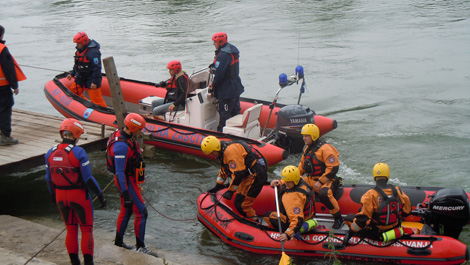


Инструменти за достъп за хора с увреждания
Инструменти на сайта
Избор на език
Навигационна пътека
Heavy rains have led to a rising of river levels and floods in parts of the Czech Republic, Germany and Austria. There are 18 victims. The situation is still unfolding: waters are receding in some areas and continue to rise in others.

Click here for bigger map ![]() [920 KB] .
[920 KB] .
In the Czech Republic, ten people are reported dead. The water levels are decreasing. Floods containment, pumping and clean-up are ongoing. The Czech Republic has accepted assistance from Poland, Germany and Slovakia.
In Austria, there are five victims and two people are reported missing. Clean-up is ongoing in the flooded areas. The risk of landlslides remains.
In Germany, three people have lost their lives. The flooding situation is slowly improving along the Danube but still critical with the Elbe. In Saxony-Anhalt many dikes are flooded, some are broken and evacuations are going on. Germany has accepted assistance from Belgium, Denmark, Luxembourg and the Netherlands.
In Slovakia, the situation around Bratislava is stable. Despite record water level of the Danube, flood-countering measures have helped prevent major damage.
In Hungary, protection works go on in critical areas. The flooding is now moving downstream from Budapest.
In Serbia, water levels are reportedly rising. Protection activities are taking place.

The Emergency Response Centre (ERC) is the only entity which keeps an overview of developments across Europe. It is monitoring the situation and is in constant contact with the authorities in the affected countries. So far, there has been no request for assistance through the EU Civil Protection Mechanism, but satellite images of the flooding evolution have been provided through the ERC.
The EU Civil Protection Mechanism, managed through the ERC, has at its disposal 30 flood-related response modules, registered by 11 countries.
One of the most disaster-prone regions in the world, Europe is especially susceptible to floods – the disaster that takes the most lives and causes the most damage on our continent.
A majority of EU citizens (82%) agree that a coordinated EU response to disasters is more efficient than the actions of individual countries. The coordination of joint operations in this area is facilitated by the EU Civil Protection Mechanism. It has 32 participants – the 27 Member States of the EU, plus Croatia, the former Yugoslav Republic of Macedonia, Iceland, Lichtenstein and Norway. The participants pool resources with which they can assist disaster-hit countries and exchange best practices in disaster management.
Following the rising number and intensity of disasters and the growing need for assistance, the EU's disaster response coordination has evolved. Since its creation in 2001, the EU Civil Protection Mechanism has been activated over 150 times, for different types of disasters.